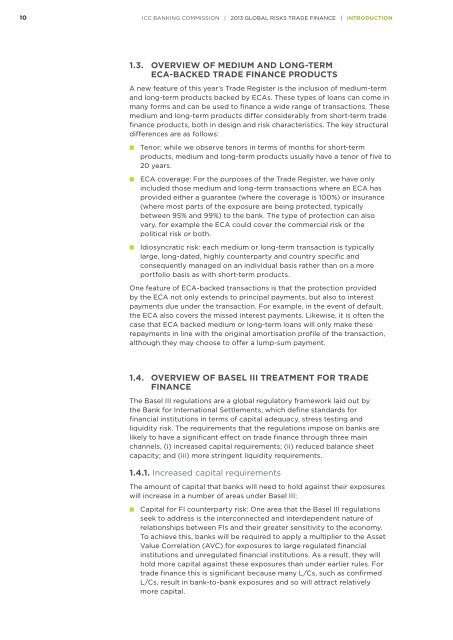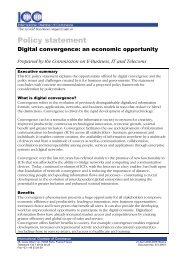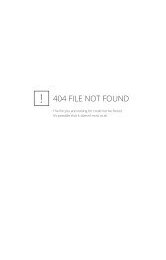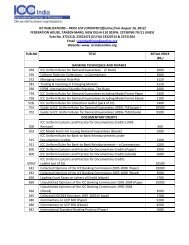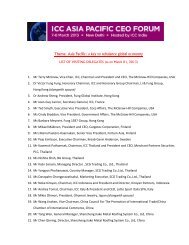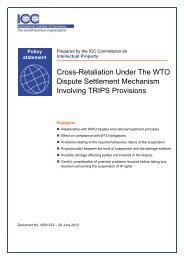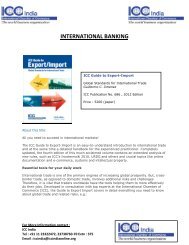2013 - ICC India
2013 - ICC India
2013 - ICC India
- No tags were found...
Create successful ePaper yourself
Turn your PDF publications into a flip-book with our unique Google optimized e-Paper software.
10<strong>ICC</strong> BANKING COMMISSION | <strong>2013</strong> GLOBAL RISKS TRADE FINANCE | INTRODUCTION1.3. OVERVIEW OF MEDIUM AND LONG-TERMECA-BACKED TRADE FINANCE PRODUCTSA new feature of this year’s Trade Register is the inclusion of medium-termand long-term products backed by ECAs. These types of loans can come inmany forms and can be used to finance a wide range of transactions. Thesemedium and long-term products differ considerably from short-term tradefinance products, both in design and risk characteristics. The key structuraldifferences are as follows:■■■■■■Tenor: while we observe tenors in terms of months for short-termproducts, medium and long-term products usually have a tenor of five to20 years.ECA coverage: For the purposes of the Trade Register, we have onlyincluded those medium and long-term transactions where an ECA hasprovided either a guarantee (where the coverage is 100%) or insurance(where most parts of the exposure are being protected, typicallybetween 95% and 99%) to the bank. The type of protection can alsovary, for example the ECA could cover the commercial risk or thepolitical risk or both.Idiosyncratic risk: each medium or long-term transaction is typicallylarge, long-dated, highly counterparty and country specific andconsequently managed on an individual basis rather than on a moreportfolio basis as with short-term products.One feature of ECA-backed transactions is that the protection providedby the ECA not only extends to principal payments, but also to interestpayments due under the transaction. For example, in the event of default,the ECA also covers the missed interest payments. Likewise, it is often thecase that ECA backed medium or long-term loans will only make theserepayments in line with the original amortisation profile of the transaction,although they may choose to offer a lump-sum payment.1.4. OVERVIEW OF BASEL III TREATMENT FOR TRADEFINANCEThe Basel III regulations are a global regulatory framework laid out bythe Bank for International Settlements, which define standards forfinancial institutions in terms of capital adequacy, stress testing andliquidity risk. The requirements that the regulations impose on banks arelikely to have a significant effect on trade finance through three mainchannels, (i) increased capital requirements; (ii) reduced balance sheetcapacity; and (iii) more stringent liquidity requirements.1.4.1. Increased capital requirementsThe amount of capital that banks will need to hold against their exposureswill increase in a number of areas under Basel III:■■Capital for FI counterparty risk: One area that the Basel III regulationsseek to address is the interconnected and interdependent nature ofrelationships between FIs and their greater sensitivity to the economy.To achieve this, banks will be required to apply a multiplier to the AssetValue Correlation (AVC) for exposures to large regulated financialinstitutions and unregulated financial institutions. As a result, they willhold more capital against these exposures than under earlier rules. Fortrade finance this is significant because many L/Cs, such as confirmedL/Cs, result in bank-to-bank exposures and so will attract relativelymore capital.


